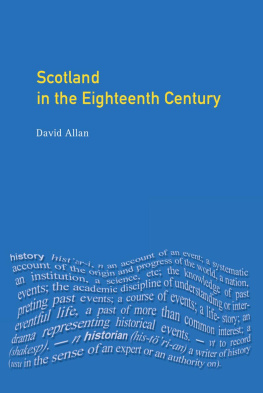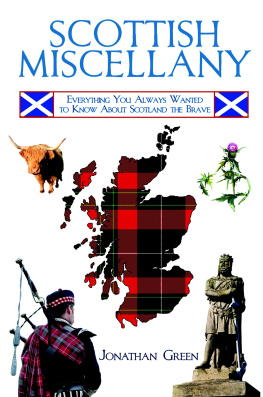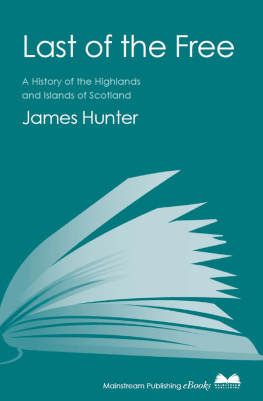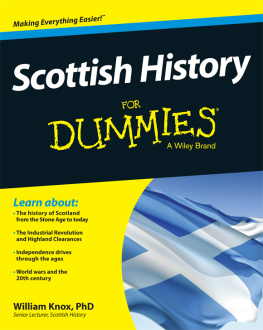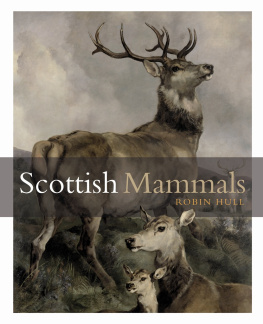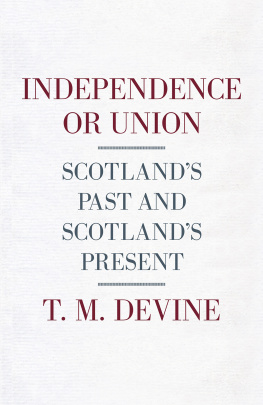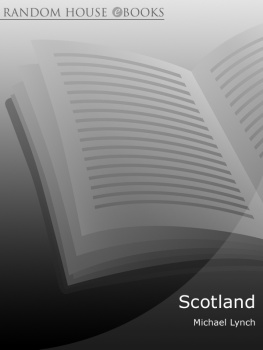THE SOCIAL AND INDUSTRIAL HISTORY OF SCOTLAND
From the Union to the Present Time
JAMES MACKINNON

This 2011 edition published by Barnes & Noble, Inc.
All rights reserved. No part of this publication may be reproduced, stored in a retrieval system, or transmitted, in any form or by any means, electronic, mechanical, photocopying, recording, or otherwise, without prior written permission from the publisher.
Barnes & Noble, Inc.
122 Fifth Avenue
New York, NY 10011
ISBN: 978-1-4114-4885-8
PART I
THE EIGHTEENTH CENTURY
1. G ENERAL A SPECT
Looking merely on the surface, the eighteenth, compared with the seventeenth, might be described as a tame century. Apart from the two Jacobite Risings in 1715 and 1745, it is singularly undramatic. Politics lapsed to the level of the petty animosities of Whig and Jacobite and these gradually died away after the cause of the exiled Stuarts had received its death blow at Culloden. Jacobitism survived only in the romantic songs in which a sentimental allegiance to an impracticable ideal found pathetic expression. The Union from which so much had been hoped, and for which so much had been sacrificed, seemed for long a failure, and only five years after its consummation a proposal was made in the Parliament at Westminster to dissolve it. The eagerly expected prosperity did not come till well into the century. The people had not the same interest in politics as in the days when political and ecclesiastical affairs were debated and decided in the Scottish Capital. Scottish members and purely Scottish questions figured little in the greater assembly at Westminster, where Scottish interests were viewed by English politicians from the standpoint of those of English parties. The limitation of the franchise to a handful of voters in both burghs and counties (about 4000 in all) deprived politics of the magnetic attraction of the days before the Union and the Revolution, when men and parties contended over questions of such far-reaching importance in Church and State. This political lassitude endured throughout the century when Scotland, in marked contrast to the previous century, submitted to the bureaucratic rgime of "uncrowned kings" like Henry Dundas.
Happily, this stagnation was confined, except in the political sphere, to the first half of the century. The second half of it was a period of new vitalitywhich showed itself in a marked transformation of the national life. The Union at last proved its efficacy in the quickening of commerce, of which Glasgow was the great centre. Industry made a great bound forward in the rapid development of the linen, woollen, cotton, and iron manufacture to which the application of improved machinery and especially the inventive genius of James Watt gave a powerful impulse. Agriculture shared in the advance of other industries in a remarkable degree. Shipbuilding and the improvement of communication by land by the construction of roads and canals greatly favoured commercial and industrial expansion and social progress. In literature, science, philosophy, art, education, Scotland sprang from the mediocrity of former days into a brilliant position among the nations. Its social life also underwent a marked betterment in many respects as the result of the accumulating wealth which raised the rate of wages and the standard of living. Its religion lost much of its old narrowness and crudeness under the influence of a broader culture. The energy which in the previous century had exhausted itself with such grim intensity in violent political and ecclesiastical contention was directed into the channel of practical life. The second half of the eighteenth century equally with the seventeenth may be described as a period of revolution. Only the revolution takes the form, not of a convulsion of the body politic, but of a truly formative, if less obtrusive process of industrial and social advance.
2. T HE P ROGRESS OF A GRICULTURE
During the first half of the eighteenth century there was no appreciable advance in agriculture, though enterprising and enlightened landowners like Adam Cockburn of Ormiston, and his son John, and the Earl of Haddington set a praiseworthy example in adopting new methods to increase the productiveness of their estates. Their example was, however, but sparingly followed, and it is only in the second half of the century that a notable advance becomes observable. Even towards its close it was far from complete, the old methods surviving alongside the new in the more sequestered districts of the Lowlands, not to speak of the Highlands. A variety of adverse conditions worked against progress in the earlier part of the century. As the result of a series of inclement seasons at the end of the seventeenth and the beginning of the eighteenth, large tracts of land went out of cultivation and were for long left in a waste condition. Till far into the century the method of tilling the soil was still very primitive. The plough in use varied with the district. But it was usually a cumbrous implement which required four or more horses or oxen to draw it, one man to hold it, another, walking backward, to lead the team, and a third, or even a fourth, to follow it and compress the furrow and break the clods. Sometimes the crooked spade, or cascroin, worked with the hand, was used instead of the plough and the turning over of the soil involved an immense amount of manual labour. The harrows had wooden teeth which wore quickly away and merely scratched the stiffer soils. In some northern districts they were tied to the horses' tails to save the expense of providing harness.
The system of cultivation, like the mode of ploughing and harrowing, was also of a primitive kind. The farm was usually divided into "infield" and "outfield." Infield was the land nearest the steading which absorbed all the farm manure and was perpetually under crop. The outfield was the pasture land beyond, which was occasionally ploughed in patches for corn for four or five years running, when it was exhausted and then left for some years in pasture till it recovered. The system of "runrig" was also in vogue, under which a number of tenants living in a town or village cultivated the adjacent land, divided into "rigs" or ridges which changed hands every yeara practice very adverse to enterprise on the part of the individual cultivator. Another common method was to lease a farm to a number of tenants, each cultivating his separate portion, but each dependent on the consent of the others in the working of it.
The land was usually leased to tenants by the year and this short and uncertain tenure tended to discourage enterprise. As the cultivator might be turned adrift at the end of the year, he had no incentive to improve the land, and if, nevertheless, he attempted to do so, his rent might be raised. Without a reasonably secure tenure in the form of longer leases, agricultural improvement was impossible. What could be done by this expedient was conclusively shown by Adam Cockburn of Ormiston, Lord Justice Clerk at the beginning of the century, whose wise policy was continued and extended by his son John, with most beneficial results to both landlord and tenant. The generality of proprietors were, however, all too slow to profit from such an example. Moreover, rents were paid largely in kind and only to a comparatively small extent in money. Money was, indeed, very scarce throughout the first half of the century and without money it was impossible for the proprietors to improve their estates. Loans for such a purpose were very difficult to raise and could only be obtained on "wadset," which pledged the land of the borrower to the lender if the loan was not repaid by a specified date. The enterprise of the tenant was farther hampered by the remains of the feudal obligation that persisted from past centuries. Serfdom had long disappeared in the sense of binding the tiller of the soil to the estate and selling him along with it. But restrictions remained which greatly impeded his economic freedom even in the eighteenth century. Part of the rent was paid not merely in kind, but in service, which bound the tenant to give so many days' work to the proprietor in manuring and ploughing the home farm, reaping his crops, carrying peats or coals to the mansion house, such service being included in the general term


